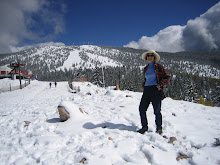Discovering Plaza Azul

Tuesday March 6
Our first day in Durango begins with a walking tour led by a local guide. Everywhere we go, men are painting, planting and watering gardens, cleaning and sweeping. The lovely Plaza de Armas is bustling with preparations for Easter. A gazebo-like structure, the 1950s-built El Kiosco de Cantera Rosa, is adorned with names of famous musicians. The musicians circle the bottom of the rotunda style roof, including Arturo Lucero, Silvestre Revellas, Ricardo Castro and Francisco Fournier. Our guide tells us that musical presentations are given every afternoon. Young men and women promenade around the plaza, girls going one direction, boys another.
Our guide walks us to the magnificent Catedral Basilica Menor. We spend time outside as exterior details are pointed out and explained. In the arch over the main door is a carved Mexican eagle. The front is also graced with statues of Matthew, Mark, Luke and John. Stepping inside, we admire the beautiful carved wooden altar and the boxy straight-backed seats on three sides behind the altar. The latter are for attending priests. To one side of the nave looms a statue of San Juan, a martyred priest who would not divulge the secrets of the Queen of Spain. On either side of the church proper are extremely wide aisles. They are spacious enough for large processions.
We linger a bit, then step out into the midday sunshine. Luis points out a “Palace of the Roses” on one side of the plaza and the “Palace of Tears” on the facing side. In the former, ladies viewed parades and other public events from the balconies. The latter, a magnificent stone edifice, now houses a MacDonald’s. At least there are no golden arches in sight.
Leaving Plaza de Armas, we encounter a crowd of people sitting in folding chairs under canopies. All eyes are on the podium. The governor of Durango, a handsome man who looks to be in his thirties, is presenting a gift to the city, a mobile air quality monitoring device. TV cameras and journalists are documenting the event.
School children and their teachers are in the audience, each school represented by a different uniform. One class wears red sweaters, white shirts and gray pants. A group of younger children are wearing navy blue warmup suits. The girls carry the same backpacks popular in the U.S. - “Hello Kitty,” “Winnie the Pooh” and “Nemo.” These are second graders, their teacher tells me.
As we leave the political gathering, our guide informs us that this plaza was founded by the Jesuits 400 years earlier and that in 1767, the Jesuits were expelled. Next stop is the Palacio Municipal, where we admire the graceful arches and central plaza. The building is filled with dramatic, colorful historical murals including one of Benito Juarez with Abraham Lincoln. More sightseeing and then a pleasant afternoon stroll back to Hotel Casablanca.
The city tour planned for this evening falls through. The appointed bus never comes to pick us up. Louann, Inez, Joan and I decide to walk to a seafood place that Hal tried and liked on a previous Mexico trip. We find the restaurant several blocks from the hotel, but it’s closed. By now it’s dark and slightly cold. In our quest to find another eatery in the neighborhood, we check with some neighboring businesses. Amazingly, a Mexican family notices our plight. The driver, who must be Papa, says that they also are going out to dinner. They know a place nearby and invite us to pile into their car and go with them.
It is a tight squeeze, but we four Americanos stack ourselves in the back seat and went with our Mexican “rescuers.” The destination (and ours) is Plaza Azul, a delightful seafood restaurant with high ceilings, a yellow 1928 Ford in one corner, a Western movie playing silently on an overhead TV, and a bar resplendent with colored lights. Our server brought miniature coat racks to put at the corners of our table for our jackets, and we enjoyed a dinner of cerveza and various seafood dishes. The helpful family, who refused to take a single peso for chauffeuring us, sat at a nearby booth. I like to think that our obvious enjoyment of Playa Azul was a sort of payment for their good deed.







0 Comments:
Post a Comment
<< Home